
The red-flanked bluetail, also known as the orange-flanked bush-robin, is a small passerine bird that was formerly classed as a member of the thrush family Turdidae, but is now more generally considered to be an Old World flycatcher, Muscicapidae. It, and related species, are often called chats.

The Old World flycatchers are a large family, the Muscicapidae, of small passerine birds restricted to the Old World, with the exception of several vagrants and two species, bluethroat and northern wheatear, found also in North America. These are mainly small arboreal insectivores, many of which, as the name implies, take their prey on the wing. The family is relatively large and includes 357 species, which are divided into 54 genera.

The Indian blue robin is a small bird found in the Indian Subcontinent. Formerly considered a thrush, it is now considered one of the Old World flycatchers in the family Muscicapidae. It was earlier also called the Indian blue chat. It is migratory, breeding in the forests along the Himalayas of Nepal, India, Myanmar and Bangladesh. They winter in the hill forests of the Western Ghats of India and in Sri Lanka.

The rusty-tailed flycatcher is a small passerine bird in the flycatcher family Muscicapidae. It is found mainly in the northern regions of the Indian Subcontinent and some parts of southwest India, as well as pockets of Central Asia including Uzbekistan and Tajikistan. The species is partially migratory, with the Central Asian populations migrating to India, as far as the southwest Indian coast along the Arabian Sea, to Karnataka and Kerala.

Brachypteryx is a genus of passerine birds in the family Muscicapidae containing ten species known as shortwings, that occurs in southeast Asia.

The fiscal flycatcher is a small passerine bird in the Old World flycatcher family. It is the only species placed in the genus Sigelus. It is a resident breeder in Botswana, South Africa, Lesotho, Mozambique and Swaziland, and a vagrant to Namibia.

Melaenornis is a genus of small passerine birds in the large family Muscicapidae commonly known as the Old World flycatchers. They are restricted to sub-Saharan Africa.

The chat flycatcher is a small passerine bird in the Old World flycatcher family Muscicapidae that is native to southern Africa.

The pale flycatcher is a passerine bird of the Old World flycatcher family Muscicapidae, found in Sub-Saharan Africa.

The green cochoa is a bird species that was variously placed with the thrushes of family Turdidae or the related Muscicapidae. It is considered closer to the former.

Cyornis is a genus of birds in the Old World flycatcher family Muscicapidae most of which are native to Southeast Asia.

Eumyias is a genus of birds in the Old World flycatcher family Muscicapidae.

Phoenicurus is a genus of passerine birds in the Old World flycatcher family Muscicapidae, native to Europe, Asia and Africa. They are named redstarts from their orange-red tails. They are small insectivores, the males mostly brightly coloured in various combinations of red, blue, white, and black, the females light brown with a red tail. A molecular phylogenetic study published in 2010 led to a reorganization of the Old World flycatchers family in which the two species in Rhyacornis and the single species in Chaimarrornis were merged into Phoenicurus.

The Flores jungle flycatcher is a passerine bird in the Old World flycatcher family Muscicapidae that is endemic to the Lesser Sunda Islands.

The white-browed bush robin is a species of passerine bird in the Old World flycatcher family Muscicapidae that is found from the Himalayas to south-central China and north Vietnam. Its natural habitat is Rhododendron and conifer forests. The Taiwan bush robin was formerly regarded as a subspecies.

The Himalayan bluetail, also called the Himalayan red-flanked bush-robin or orange-flanked bush-robin, is a small passerine bird that was formerly classed as a member of the thrush family Turdidae, but is now more generally considered to be an Old World flycatcher of Muscicapidae. While currently under review, this taxon is not current recognized as a species by BirdLife international.

The Nicobar jungle flycatcher is a species of bird in the Old World flycatcher family Muscicapidae. It is endemic to the Nicobar Islands, where its natural habitats are subtropical or tropical moist lowland forests and subtropical or tropical mangrove forests. It was at one time considered a subspecies of the brown-chested jungle flycatcher.

Larvivora is a genus of small passerine birds belonging to the Old World flycatcher family Muscicapidae that occur in central and eastern Asia.

The Qilian bluetail is a small passerine bird of Old World flycatcher, Muscicapidae. It is distributed in north-central China, and was first described by Wilhelm Meise as a subspecies of the red-flanked bluetail in 1937. It was previously usually considered invalid, until accepted by Hadoram Shirihai and Lars Svensson in 2018, and it was proposed to be a full species in a molecular phylogenetic study published in 2022; this has now been accepted by the IOC World Bird List. It is distinctive in genetics and vocalisation, but only marginally different in morphology. The males have bluer fore-supercilium, and less white than in red-flanked bluetail.

The Taiwan bush robin is a small passerine bird in the Old World flycatcher family Muscicapidae that is endemic to Taiwan. It was formerly considered as a subspecies of the white-browed bush robin.




















